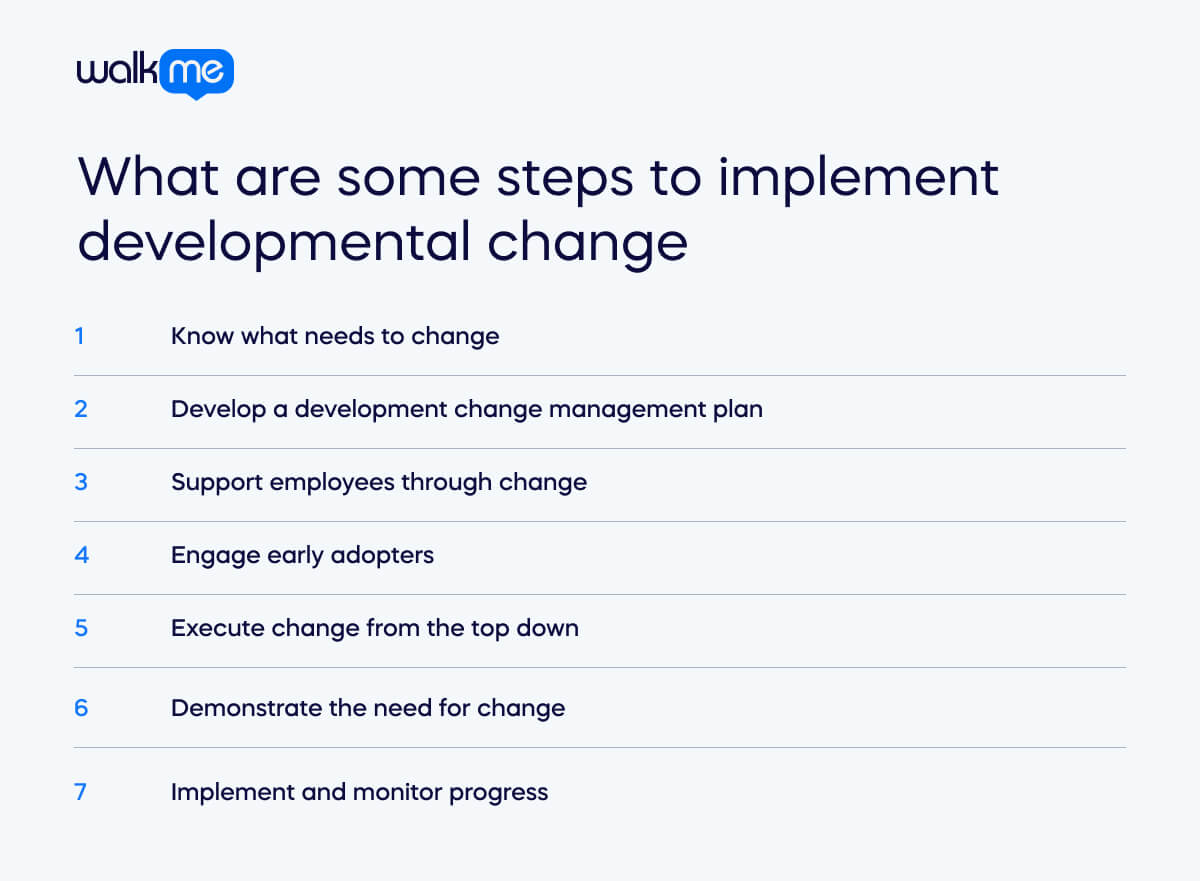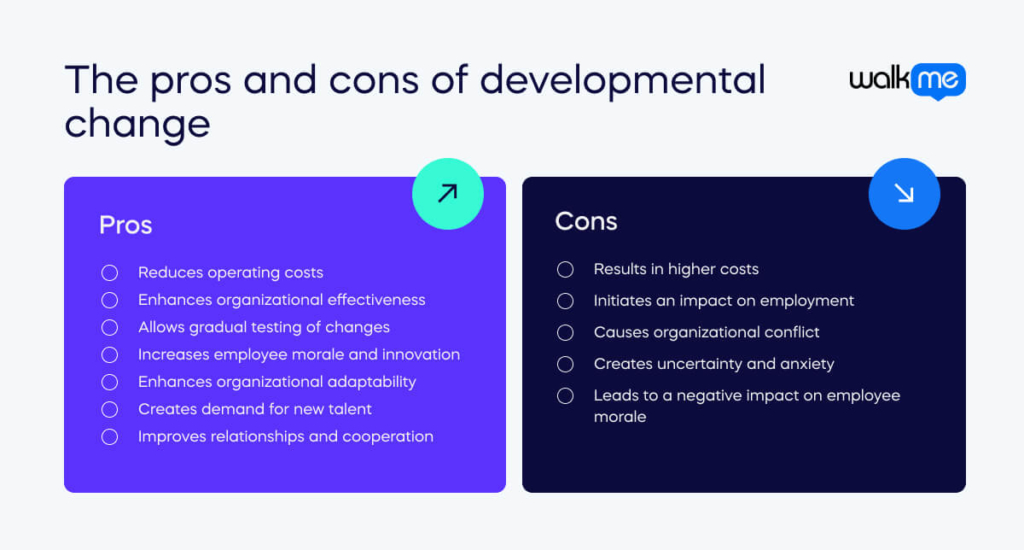Successfully implementing change helps businesses stay current with market trends and ensures compliance with new standards while minimizing disruption. Understanding different types of change — and how to adapt to them — is essential for long-term resilience.
Developmental change takes place when a business seeks to alter or improve day-to-day operations. This might mean streamlining internal processes, such as updating payroll systems to save time in people management, or refining external strategies, like rethinking a digital marketing approach to better engage customers. Unlike disruptive transformation, developmental change often occurs gradually as organizations refine existing structures rather than replace them.
To deliver lasting results, developmental change should be supported by clear change management, helping employees understand the purpose behind adjustments and adopt new ways of working smoothly.
In this guide, we’ll define developmental change, explore its purpose, discuss strategies for implementation, and share examples, benefits, and challenges.
What is developmental change?
Developmental change enhances existing processes and procedures. It does not need large-scale adjustments. These frequent changes aim to improve efficiencies and fix deficiencies. They can also build on past successes.
They are gradual and non-disruptive, which reduces resistance within an organization. Over time, these small improvements can accumulate and benefit the company. By keeping up with industry improvements, they drive value and prevent loss of market share.
What is the purpose of developmental change?
Developmental change aims to enhance current practices rather than introduce new ones. Examples include improving sales, quality, interpersonal communication skills, work processes, team dynamics, and problem-solving abilities.
Managing developmental change involves using standard change management tools. These tools include stakeholder analysis, communication plans, and employee training programs. They help integrate new technologies or processes into existing frameworks.
What are some steps to implement developmental change

To achieve successful developmental change, you must execute many phases to ensure a smooth transition.
The various stages are:
Know what needs to change
The first important step in implementing developmental change in your organization is to identify the specific changes needed. These changes should align with your company’s overarching objectives and strategic direction.
Conducting an impact assessment is essential at this stage. This assessment evaluates how these changes will affect different levels of the organization. An employee training plan can be used to identify key areas that need support. By understanding the potential impact upfront, you can better prepare and tailor your implementation strategy.
Develop a development change management plan
Once you identify goals and impacts, the next step involves developing a comprehensive change plan. This plan should outline clear objectives, detail the specific changes required, and set measurable criteria for success.
It’s important to involve stakeholders at this stage, including decision-makers, managers, and employees. Their perspectives and insights can provide valuable input into refining the change strategy and ensure alignment with organizational goals.
Support employees through change
Change can often be met with resistance. This stems from fear of the unknown or concerns about disruption. Supporting employees through developmental change is crucial for successful implementation.
Initiatives such as mentorship programs to guide employees through new processes and cross-training opportunities are important. Open communication channels where employees can seek help and clarity are also necessary. Recognizing these concerns early on helps build trust. It also reduces disruptions to daily operations.
Engage early adopters
Engaging early adopters within your organization can enhance the adoption of change. These individuals are enthusiastic about innovation.
They can play a pivotal role in championing the benefits of developmental change. By leveraging their influence, you can create momentum and excitement around the change initiative, encouraging broader participation and buy-in across the organization.
Execute change from the top down
Effective developmental change implementation starts at the top. Senior executives and leaders must understand the rationale behind the changes and communicate and support them throughout the organization.
They can advocate for change, ensure consistent messaging and alignment across departments and teams, and provide clear guidance and comprehensive training materials to further facilitate adoption.
Demonstrate the need for change
Demonstrating the necessity of developmental change is crucial for gaining employee support. Utilizing data-driven insights, such as customer feedback, market trends, or performance metrics, helps substantiate the need for change.
Transparently communicating these reasons and emphasizing the anticipated benefits fosters understanding. It motivates employees to take part in the change process. Employees are more likely to embrace change when they perceive its relevance to their work.
Implement and monitor progress
Executing the change management plan requires ongoing monitoring and evaluation of progress. Assessing milestones and gathering employee feedback allows you to identify any challenges or issues early on.
This approach enables you to make necessary adjustments to strategies and tactics. It ensures alignment with organizational objectives and maximizes the likelihood of successful implementation.
What are some practical examples of developmental change?
Here are some ways that organizations have chosen to implement developmental change:
McDonald’s
McDonald’s has long excelled in developmental change. This is evident recently with their update to the Happy Meal box. But, their most significant success lies in the McCafé transition.
In recent years, coffee tastes have evolved. Coffee has become both stronger and sweeter. Younger coffee drinkers want more flavorful brews and various confections. In contrast, seniors, who comprise a large segment of McDonald’s coffee customers, prefer their coffee unchanged. They do not want espressos, lattes, syrups, or anything beyond normal coffee.
To address this challenge, McDonald’s executed a careful and gradual plan. Over two years, they gradually increased the strength of their basic coffee each month, quietly, without announcing the changes. Today, everything on the menu, including regular coffee, falls under the McCafé brand.
The lesson here is clear. Small, developmental steps often lead to success more smoothly than abrupt changes. Progressing slowly can yield better results. This approach creates a larger and happier customer base with less resistance.
Irvine Company
Irvine Company, a real estate firm in California, transitioned its 5,000 employees from Microsoft to Google Apps for Work. They focused on three key steps: capturing attention, securing approval, and orchestrating adoption.
Irvine Company told a positive story about the benefits of switching to Google Apps. They emphasized collaboration and faster decision-making. They involved employees early by asking for their input on productivity needs. They shared a clear vision of the future.
The IT team discussed the new platform’s benefits and challenges. To keep things simple, they started with email and calendar services. This approach helped gain support from everyone involved and built positive momentum for future changes.
To help employees adjust, Irvine Company provided hands-on support. They set up “Next Lounges” for employees to try out the new technology. They trained employees as Google guides for one-on-one help. They sent IT staff to assist in person when needed.
Irvine Company ensured a smooth transition by focusing on people rather than technology. They captured employees’ interest, gained their support, and provided the necessary help for adopting new habits, leading to a successful switch to Google Apps for Work.
CoachHub
CoachHub, started in 2018 by brothers Matti and Yannis Niebelschütz, aimed to make business coaching accessible to everyone. They began with a simple website and clear goals. Today, CoachHub is a global digital coaching provider. It has over 3,500 certified coaches and $330 million in funding.
Matti and Yannis began with small goals. By doing this, they embraced developmental change. In the first instance, they wanted to build a basic product, get 30 coaches, and find 10 paying clients. Soon, they achieved these goals.
This allowed them to scale up. They expanded across Europe and acquired MoovOne in France. Now, they have over 700 employees in 90 countries, with offices in Berlin, New York, and Singapore.

What are the benefits of developmental change?
The various advantages of developmental change are:
Reduces operating costs
Implementing process changes, such as incorporating new technologies or practices, can decrease operating costs. Lowering input requirements relative to outputs makes the business more efficient, enhancing employee productivity and cost-effectiveness.
Enhances organizational effectiveness
Developmental change boosts an organization’s ability to achieve its goals. Increased effectiveness may result from structural changes that improve the division of labor.
It can also stem from new processes that enhance output quality or quantity. Shifts in organizational culture can make employees more responsive and productive.
Allows gradual testing of changes
Developmental change allows you to test and implement small changes before larger ones. This approach enables greater flexibility and responsiveness to changing circumstances. It also allows for necessary adjustments, ensuring sustainable and effective changes.
Increases employee morale and innovation
Staff in companies resistant to change might feel stagnant and unchallenged. Embracing developmental change encourages staff to innovate and get new skills. This increases morale and attracts new talent to the organization. It also promotes a dynamic and growth-oriented environment.
Enhances organizational adaptability
The best organizations are adaptable and can respond to market disruptions. A well-planned developmental change makes an organization more agile and ensures better preparation to handle various situations. This adaptability helps maintain competitiveness in an evolving market.
Creates demand for new talent
Organizational changes often require new talent to implement changes and fill new roles. This demand benefits job seekers by increasing the availability of various jobs. If enough companies seek these new skills, it can also lead to higher average incomes, contributing to a healthier job market.
Improves relationships and cooperation
Developmental change can lead to better relationships between employees, departments, and customers. When changes are executed well, cooperation and understanding improve across different organizational levels, leading to a more harmonious and efficient work environment.
What are the challenges of developmental change?
But you also need to be aware of its various limitations:
Results in higher costs
Developmental change can be expensive. It requires significant investments in money, time, and personnel. This investment may involve hiring more staff or purchasing new technology or equipment. It could also include training existing employees. Implementing new processes and procedures may raise operational costs.
Initiates an impact on employment
While developmental change can increase employment for new talent, it can also reduce the need for certain skills. Many technologies that automate tasks decrease employer demand for specific roles. This can lead to job losses or reduced opportunities in certain areas.
Causes organizational conflict
Developmental change often leads to conflict within the organization. Stakeholders may have different interests or perspectives on achieving organizational processes. This can cause disagreements between management and employees. Conflicts can also arise when stakeholders hold differing views on the changes.
Creates uncertainty and anxiety
Frequent developmental changes can create uncertainty about the organization’s future. Current staff may worry about job security. Investors might fear that constant changes show financial instability. This uncertainty can affect confidence in the organization.
Leads to a negative impact on employee morale
Developmental change can harm employee morale, especially if employees feel excluded from the change process. If employees believe their opinions were not considered, they may feel undervalued. This can lead to a sense of insecurity about their roles and uncertainty about their future prospects within the organization.
Final steps in terms of developmental change
Engaging employees in developmental change processes is crucial for gaining their support. The earlier you involve employees in formulating strategies, the better the chances of reducing resistance. Employees who feel included in the reasons behind the change are more likely to embrace the initiatives.
To foster employee engagement, consider involving them in key aspects of the change process. Start by collaborating with staff to build a compelling case for change. Ensure they understand the vision for the desired future state.
Provide training and development opportunities focused on mindset, behavior, and change management. Equipping staff with these skills prepares them for the changes ahead and empowers them to contribute to the business process transformation.
Gather insights into employees’ expectations through an employee feedback loop. This input helps align organizational changes with external market demands and benchmarks.
Empower employees to design local changes that impact their day-to-day work processes. Employees often have deep insights into operational efficiencies and potential improvements, making them invaluable partners in designing and implementing effective changes.
Organizations can enhance adoption rates and reduce resistance in this way. You need a holistic approach that integrates employee development with strategic change management. Adaptability and responsiveness are key to sustaining a competitive advantage.
Frequently Asked Questions
By introducing AI in small pilots—such as automating routine tasks—organizations can integrate intelligence gradually, minimizing disruption while demonstrating ROI and building user confidence.
Developmental change improves existing processes incrementally, reducing perceived risk and resistance, making stakeholder support more attainable.
When incremental improvements begin altering roles or processes significantly enough that a planned transition between defined states is required.
Yes. Revisiting minor process enhancements or capability building—such as targeted training or system tweaks—can reignite progress without needing major overhaul.

